Moment’s Daniel Pearl Investigative Journalism Initiative (DPIJI) was established in memory of the Wall Street Journalreporter slain by terrorists in 2002. DPIJI provides grants to support in-depth stories about anti-Semitism and other prejudices.
On the morning of October 7, Tahseen, his mother Kochar and a dozen siblings, cousins, aunts and uncles stuff themselves and several bags of belongings into taxis and head up into the hills of Iraqi Kurdistan. They call the drivers to a stop just after passing an oil refinery and spill out into a makeshift parking lot lined with juice stalls and kebab stands at the mouth of the Lalish valley.
From there, the three conical spires over the tomb of Sheikh Adi ibn Musafir, the founder of their religion, Yazidism, are just visible over the trees. So they take off their shoes, as every visitor to Lalish—the faith’s holiest site—must, and add them to the bags. They then join the hundreds of pilgrims carrying blankets, food, gas cookers and small children up toward the valley’s end, ready to celebrate Cemaiya, the seven-day-long Feast of the Assembly.
Tahseen, Kochar and the others follow a path under oak trees and through olive groves, stones sharp under their feet. Tahseen grins as he walks, a big, happy grin that reveals the gold tooth in the upper left side of his mouth. He is back in Iraq after four years in Germany and reunited with Kochar, who had stayed behind and whom he has sorely missed.
It is their first time in Lalish since the genocide that fractured their family. In August 2014, ISIS attacked the Sinjar region, which is 85 miles west of Lalish and was home to most of Iraq’s Yazidi community, including Tahseen’s family. The militants killed or kidnapped approximately 12,000 of the Kurdish-speaking minority not lucky or quick enough to get away.
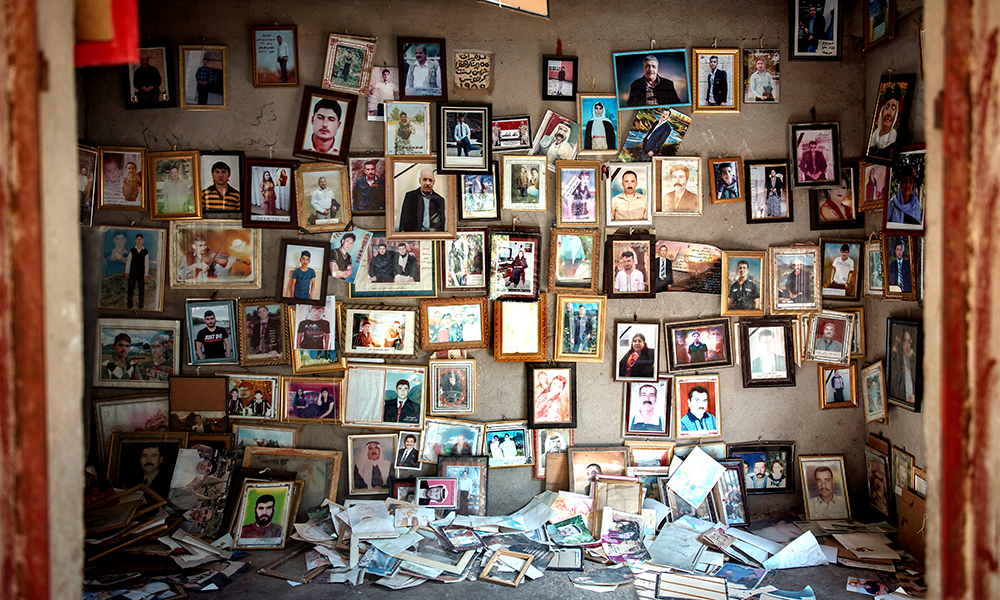
Portraits of missing Yazidis hang in Lalish.
The path climbs gently for about a mile, ending in the complex of shrines, chapels, bridges and stairways built up around Sheikh Adi’s tomb. By the time Tahseen’s family arrives, teenagers are already squeezed together anywhere with a view of the paved central courtyard, posing for selfies above arched stone alcoves. Kochar finds the family space under an old oak on a terraced section of valley. They string a tarpaulin from the tree’s trunk, wedge their bags in the split of its low branches and set up a stove to brew tea.
I join them there. Tahseen is 28, a sturdy five-foot-nine with a neat beard, a firm handshake and the sun-starved skin that identifies pilgrims living abroad. Kochar sits to his left, round-faced and time-worn, with tattooed hands. She is not sure how old she is but tells me she feels 70—likely an overshoot of two decades. She still lives in an unfinished building outside the nearby town of Shekhan, where the family ended up after escaping the ISIS advance.
Kochar wants to hear about Tahseen’s life since he has joined the mass migration that took tens of thousands of Yazidis to Europe in 2015. He left because, as the oldest of five brothers, he had to earn money to support Kochar, who has never recovered from the injuries inflicted by an al-Qaeda car bomb in 2007 and whom Tahseen’s father had abandoned for two younger wives. That was how it had been since she pulled him out of school at age 12 to carry bags of cement on construction sites or to work shifts in local shops.
So Tahseen tells her about his job driving a forklift at a Müller warehouse in Stuttgart, which allows him to send her money and rent a small apartment for himself. He speaks German now, which impresses Kochar, and has learned to cook, which makes her feel guilty.
He tells her how on weekends, he sometimes drives across the border to Austria and up into the mountains near Switzerland, which are high and green and sometimes snow-capped, and which he can’t help but find more beautiful than the Sinjar peaks.
Tahseen tells her, too, how he would like to get married, although he is not sure how to find a wife in Stuttgart as she would have to be Yazidi if he were to pass on his faith. “His life is difficult because he helps us and supports us,” Kochar says proudly, enjoying the opportunity to mother him again.
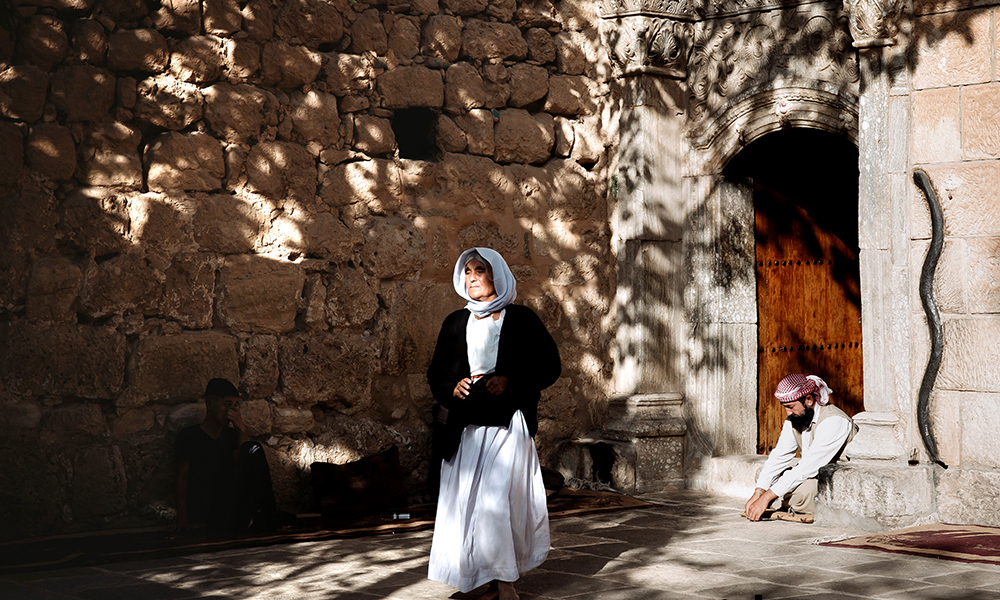
A Yazidi woman near the main temple in Lalish.
Life is difficult for her, too. She needs medical care she cannot afford and has children still too young to look after themselves. Tahseen wishes he could bring them all with him to Germany. He sees no future for himself or his family in Iraq now with the areas around Sinjar still ruined and ISIS cells operating on the plains. “I would never come back if I did not have my parents here,” he says. “If there was a way to leave, you wouldn’t find two Yazidis in Iraq.”
“Everyone wants to go,” Kochar agrees, remarking that even some religious leaders have moved their families abroad. Why, she asks, would the rest of them choose to stay when Iraq has become a place of such loss?
Since ISIS came, Yazidis have fled abroad faster and wider than ever before; to Europe, and to Canada, the U.S. and Australia, as well. There, they have become a people without a community and the land—Lalish and Sinjar—central to their identity. They have had to find new ways to practice their faith while coping with the pain of displacement and pressure to assimilate that make up the refugee experience.
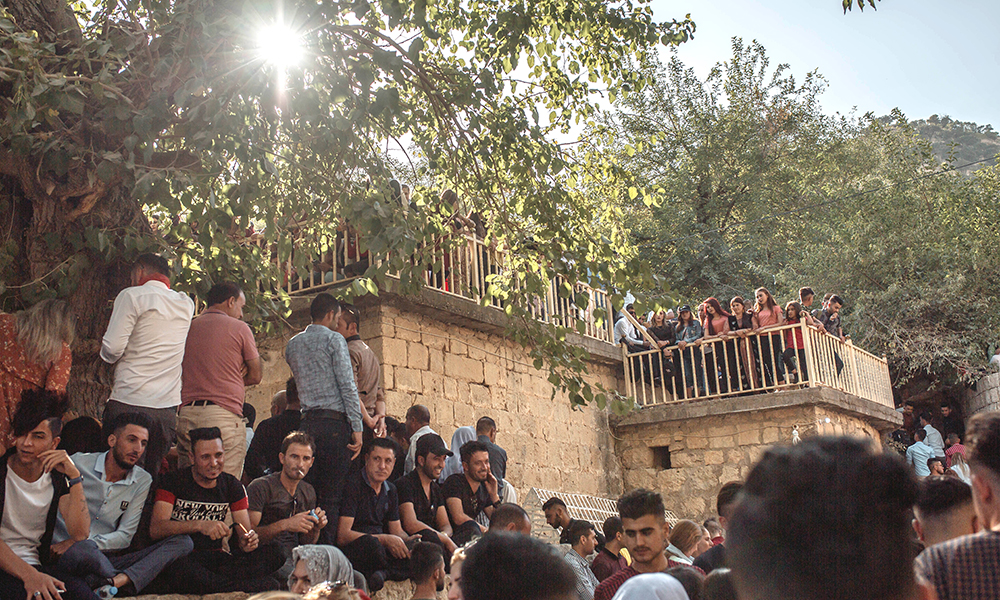
Yazidis gather in Lalish.
Unless Sinjar is rebuilt and migration staunched, Iraq’s dwindling Yazidi population may be approaching a tipping point from which it will be unable to recover. “I am afraid it’s already getting too late, and the majority of the community [in Iraq] just wants a way out to a safer place where they can start a new life,” Abid Shamdeen, the executive director of advocacy organization Nadia’s Initiative and himself a displaced Yazidi from Sinjar, tells me. “If some urgent and serious steps are not taken, the community will slowly disappear from Iraq.”
And if the Yazidis cannot survive in Iraq, can their culture—and faith—survive in the diaspora?
Sinjar refers to a region and a city. Both owe their name to the mountain range that runs some 60 miles east to west through the Nineveh governorate, jutting up hard out of the plains to a 4,800-foot peak, then rolling gradually down through valleys and terraced farmland to the Syrian border. Those peaks formed a frontier between the Hittites and Assyrians, the Romans and the Parthians, the Byzantines and the Sassanians. Later, they were home to Persians, Christians and Muslims, who each contributed spiritual elements to a religion that, by the 12th century, Sheikh Adi’s disciples had solidified into Yazidism, a combination of nature worship, Zoroastrianism and Abrahamic tenets. Yazidis are monotheistic and believe in reincarnation. According to their faith, God entrusted the world to seven angels, the foremost among them being Melek Taus, the Peacock Angel, of which its founder, Sheikh Adi, is seen as an incarnation.
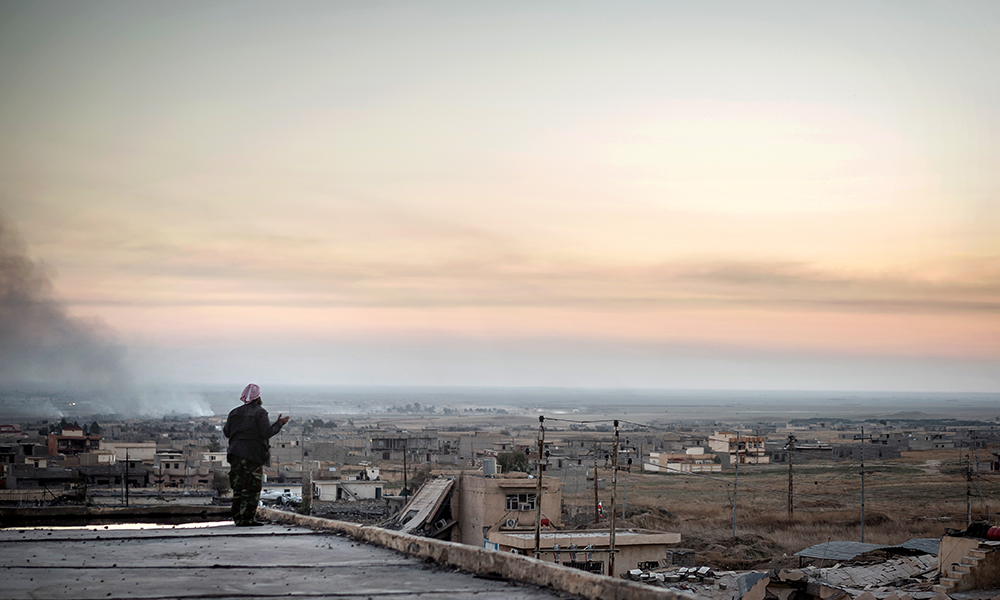
A Yazidi Peshmerga fighter prays on top of a Sinjar building after retaking the city from ISIS in 2015.
Adi’s followers were hated and feared for this syncretism, branded heretics and devil worshipers because of their veneration of Melek Taus, whom some outsiders identified with Satan. By the 1400s, local Muslim leaders had begun to see them as both apostates and rivals. The Ottomans, as well as Kurdish tribes—with whom Yazidis likely share an ancestry—made repeated attempts to wipe them out during centuries of persecution.
Isolated, the Yazidis turned inward, creating a complex protective orthodoxy that barred converts and intermarriage and discouraged time spent with members of other faiths. The mountains were their refuge and a central part of Yazidi life—home to shrines, ancestral villages and farmland. It was there, they believed, that Noah’s Ark came to rest as the floodwaters subsided. And it was there that they fled every time their enemies approached.
By the time Saddam Hussein became Iraq’s fifth president in 1979, Yazidis counted 72 genocides against them. The dictator’s rule was a time of relative peace for them, but his Arabization campaign destroyed the mountain villages and forced residents to resettle in the newly built city of Sinjar at the southern base of the mountains or in characterless square-grid towns among majority Sunni Arab villages farther out in the plains. While the Yazidis had working relationships and friendships with their neighbors, they were never truly accepted. Young Iraqi Kurds and Arabs have told me how they were taught that Yazidis worshipped the devil, that they did not wash, that one shouldn’t drink their water or eat their food.
After the U.S. invasion of Iraq in 2003, the Sinjar region became disputed territory, quarreled over by the Baghdad government and the newly created semiautonomous Kurdistan Regional Government (KRG) in Erbil. Yazidis were left vulnerable and Sunni militants began to target them with IEDs and mass killings. The 2007 bombing that injured Kochar was a massive coordinated attack that killed 796 people.
When ISIS arrived in 2014, the Sinjar region was home to around 400,000 Yazidis, by far the largest population of the group anywhere in the world.
Tahseen had never imagined leaving Tel Ezêr, a small plains town of squat, square houses south of the Sinjar mountains. Nearly everyone he knew lived there. His family’s house was there, along with their land and the old Opel Vectra he sometimes drove. So too were his many jobs: the shops, the construction sites and the taxi he rented, then drove and drove until he had found enough customers to pay for his gas.
The morning of August 2, 2014, began as usual. Tahseen and his family knew all about ISIS by then—the group had taken the nearby cities of Mosul and Tal Afar in June, announced a draconian version of Islamic law and massacred hundreds.
But the KRG’s Peshmerga troops had bases and checkpoints throughout Sinjar, and they promised to protect it. Some Yazidis did not believe that they could and tried to flee, but the Kurdish forces closed the roads and accused them of spreading rumors and panic. “They were not letting anyone leave,” Kochar remembers. “At checkpoints we heard they were humiliating and shouting at people, turning them back.”
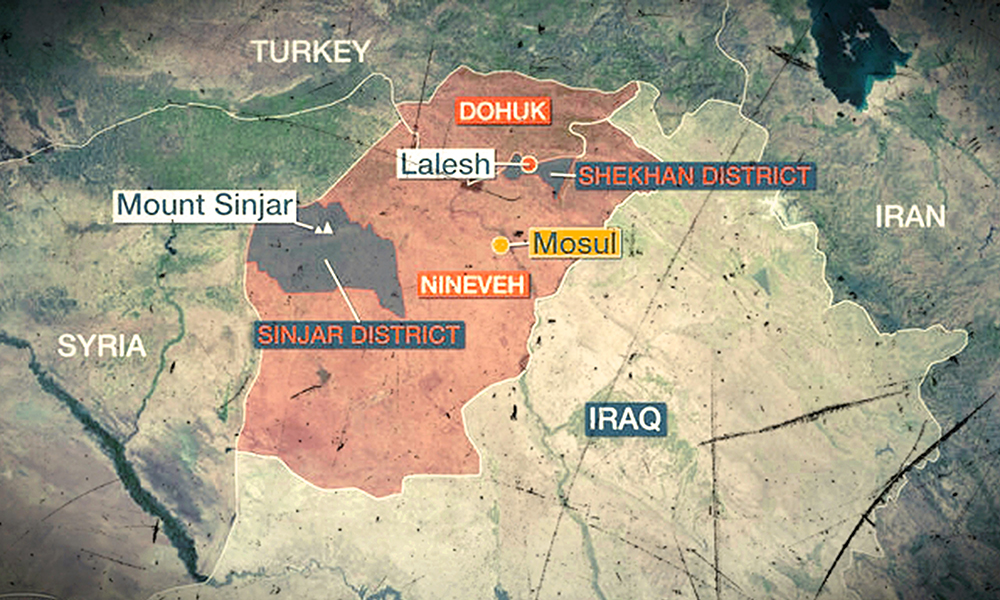
As night fell, hundreds of ISIS fighters began advancing on Sinjar in a semicircle from the south. They moved quickly, driving Toyotas and Humvees with mounted guns, taken from the Iraqi army. In some cases, Sunni neighbors with whom the Yazidis had broken bread helped the militants or even joined them. The Peshmerga had not expected the assault and withdrew suddenly, without ordering an evacuation. Most Yazidis did not know how exposed they were until frantic warnings spread via phone. In some of the outlying villages, local men gathered their weapons to try and defend themselves and allow their families to escape.
The first anyone in Tel Ezêr heard of the assault was the sound of gunfire somewhere in the dark, far away but moving closer. There was no time to pack or prepare. “We didn’t take anything, we knew they were coming for us,” says Kochar. There was only one way to go—north to the mountains—but that was some distance and Tahseen’s extended family had just two cars, the old Opel and a Chinese-made pickup. Tahseen took the driver’s seat in the Opel as women and children piled in and onto each other’s laps until the suspension rode low. Kochar found space in the pickup with a dozen others. But there was no room for many of the men, who began to walk.
Their little convoy moved out into a snarl of panicked vehicles headed toward the mountain. Tahseen drove fast and avoided the main roads, which were already controlled by ISIS. At one point the militants appeared in the distance and fired at them, so Tahseen drove faster still. When the cars could go no farther, they abandoned them and continued on foot. Back in the village, most of the men who had remained to fight were already dead, so ISIS turned their efforts to capturing any Yazidis who had not yet made it out, sweeping through residential areas and cutting off escape routes. Tahseen did not know it, but his older sister Afrah was taken with her husband and four children, while attempting to escape from their home on the other side of the mountains.
As many as 50,000 Yazidis made it to high ground and found temporary protection in the kind of terrain where even ISIS’s trucks could not follow. But there were few supplies and no shelter, and it was 100 degrees in the sun. Tahseen and Kochar’s group had some bottles of water, which they rationed out a capful or two at a time, as well as bread, which was soon moldy, but they ate it anyway. At night they gathered up piles of leaves to sleep on, and when morning came they huddled with other families under whatever shade the mountain’s sparse trees could offer. After four days, an uncle tried to sneak back to Tel Ezêr to fetch food. ISIS saw him and shot at him, so he returned with nothing. “There were so many people around us and so many of them died, especially children,” Kochar tells me. People fought over supplies, adds her sister Wadha, who is with them in Lalish. “If you had this,” she says, waving a small water bottle about a third full, “you needed a weapon to protect it.”
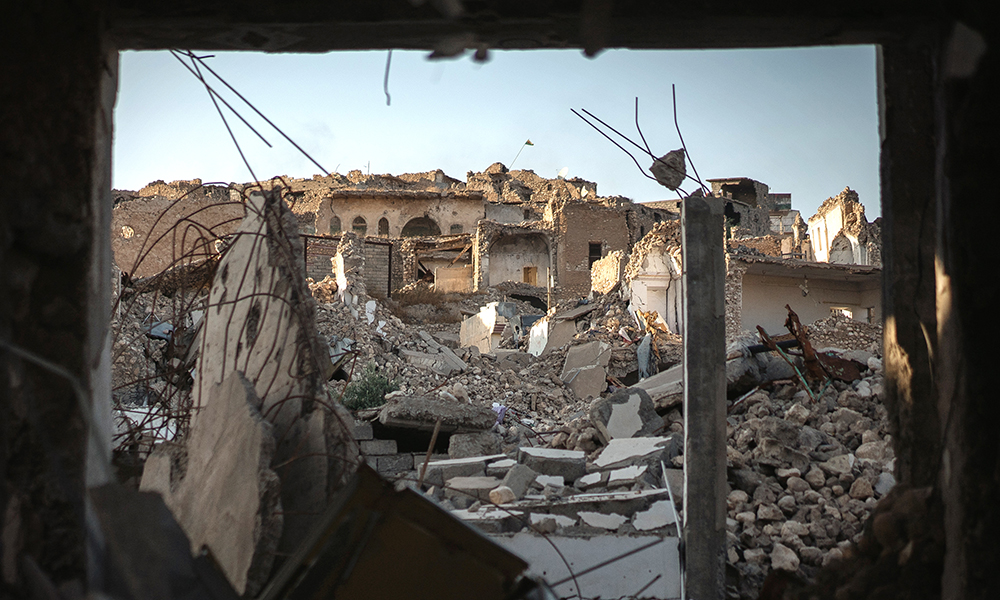
A ruined section of Sinjar’s old town.
Reports and images of their suffering made it off the mountain, and in days became international headlines. On August 7, an American C-17 and two C-130s passed overhead and dropped 5,300 gallons of fresh water and 8,000 ready-to-eat meals. Speaking in the White House’s State Dining Room that night, President Barack Obama said the U.S. had authorized limited airstrikes against ISIS and would protect the Yazidis. “These innocent families are faced with a horrible choice,” he said. “Descend the mountain and be slaughtered, or stay and slowly die of thirst and hunger.”
The strikes started the following day. British, Australian and French forces were involved too, while Iraqi helicopters were mobbed by desperate crowds as they unloaded food, water and tarps. Their efforts were not nearly enough.
Kochar’s brother paid a million Iraqi dinar (around $900) to a smuggler who could negotiate a safe route out for him and his children, but there was no room for Kochar. She watched them drive past on one of the mountain roads. “I shouted ‘Stop, take me with you,’” she says. “And he kept on driving.”
Help eventually came from other Kurdish fighters—the Kurdistan Workers’ Party (PKK), a Turkish insurgent group that also has a presence in Iraqi Kurdistan, as well as their Syrian affiliate the People’s Protection Units (YPG). The guerrillas fought their way to the mountain from the north and drove up with tractors and buses to evacuate some 40,000 Yazidis into Syria. On the tenth day after fleeing Tel Ezêr, Tahseen, Kochar and the others made it back into KRG territory via shared cars and taxis. They arrived covered in dirt and leaves and looking, Kochar thought, like they had just emerged from the grave.
ISIS subjected those left behind to deliberate and systematic violence designed to eradicate the Yazidi people and their faith. In towns and villages, the militants separated out men and prepubescent boys, then beheaded or shot some 5,000 of them, dumping their bodies in mass graves or abandoning them by the roadside.
At least 7,000 women like Afrah, and girls as young as nine, were moved through a series of holding sites in Iraq and then in Syria, where ISIS registered and examined them, then sold them as slaves. The fighters who bought them raped them repeatedly and beat them for the slightest resistance, any attempt to escape or for nothing at all. Sometimes the fighters’ families joined in the abuse. Often after a time, the women were sold on again to fresh horrors.
Tahseen and Kochar spent the first three months in Iraqi Kurdistan sleeping on blankets at a park in the city of Zakho, a few miles from the Turkish border. After that, they moved around 50 miles to the building in Shekhan, which seemed about as good as it would get for them.
Tahseen spent his days futilely looking for work. And he watched as friends, cousins and neighbors made the long journey to Europe, most ending up in Germany, where Chancellor Angela Merkel had promised refuge for anyone who needed it. In November 2015, he finally decided to follow. Kochar was worried, but Tahseen saw it as their only option. “If I go,” he told his mother, “I can feed you, I can send you money.”
He did not have a passport, so he paid a smuggler to take him across the border to Turkey and then on to the resort town of Izmir, where the beaches had become staging points for sending overloaded boats of refugees toward Greece. Hundreds had drowned in the Aegean that year already, but a million had made it and more kept on trying.
The weather had turned bad by the time Tahseen arrived, and there was nothing to do but wander past shuttered waterfront restaurants and wait in his cheap hotel for the waves and the wind to subside. A month passed but the storm remained, so the smugglers jostled him and around 80 others onto an inflatable dinghy and shoved them off anyway. They were at sea for two horrible hours. After that, Tahseen didn’t take his shoes off for 15 days—walking, then taking trains and getting off and walking again to avoid border checkpoints into countries he had never heard of. When he reached Germany, he made straight for Stuttgart, where an aunt and her two young sons had already arrived.
He wanted to fit in, and the Germans wanted him to as well. So he studied hard in his language classes and soon found the warehouse job working alongside Romanians, Poles and other Iraqis, stacking boxes of shampoo and canned food. He worked in a way that he had not before: steady eight-hour shifts, five days a week. It felt easy after his multiple jobs in Tel Ezêr, and he found that the bone tiredness he had grown used to was gone.
Within a year, his German was good enough to translate for his Iraqi workmates, and by then, he knew he wanted to stay. There was what he thought of as a humanity in Germany that he had not felt in Iraq. People were free to follow whichever faiths and traditions they wished as long as they didn’t make trouble, and he was able to pray whenever he wanted without any questions, although he often neglected to do so.
He asked around to see if there was a Yazidi temple in Germany to visit on holy days and spend time with the sheikhs who knew the hymns, or qawls, that make up the Yazidis’ mostly oral scripture. There was one, but it was 400 miles away in Hamburg, and as time passed, he never managed to visit. He still socialized mostly with Yazidis, as orthodoxy required, but they never seemed to have time for anything but work either. If one of them tried to throw a party as they used to back home, it was never well attended. He was not the only one slipping, he discovered. The children of some of his friends had already forgotten Kurdish, their parents’ language and the language of the qawls. In some families, he wondered if that had been deliberate.
Now in Lalish, he takes it all in. Every so often, he walks farther into the complex, moving with crowds dressed for the festival according to generational preference. Older women wear headscarves and flowing white, their husbands, traditional muted suits of Kurdish clothing topped with keffiyehs. Teenage girls have dyed their hair, put on dramatic makeup, their best jewelry and tight jeans or bright skirts. But the boys still try to outdo them, with elaborate gel-soaked pompadours, garish shirts and jeans fitted just as tight.
The pilgrims pass through a series of carved doorways into the temple, stepping over, never on, their sacred sills, to an inner courtyard decorated with symbols of the sun, the moon, swords, canes and combs. Lamps and wicks are lodged in niches and altars throughout the complex to be lit in a strict order as the sun sets.
Religious leaders sit there in a covered section, including Khurto Hajji Ismail, the aged Baba Sheikh, or spiritual leader, of the Yazidis. In the far corner is the ornate grey marble doorway into the main temple and a depiction of the black snake that Yazidis believe sealed a hole in Noah’s Ark when the vessel sprang a leak. Families line up to take pictures touching it for good luck.
Crowds pass through that door too, stepping into the grand nave with its seven cloth-wrapped pillars—one for each of the angels. There, they tie three knots in the cloths followed by a wish they hope will be granted when the next pilgrim unties and reties their own knots.
Some split off down the spiral staircase to a pool fed by Kani Spi, the White Spring, where Yazidis are baptized and outsiders cannot tread. Most continue on toward more shrines, past jars of olive oil pressed from the groves around the temple and a stone column where cheering groups take turns attempting to throw a small cloth so that it balances on top. When they are successful, they again make a wish.
It is a celebration marked with loss. Out in the courtyard, a young woman who has only just been freed from ISIS captivity sobs as she is reunited with family members. Another, in her early 20s with dyed red hair, had escaped in July, and tells me she is afraid that ISIS could still come after her in Iraq. Survivors like them are everywhere.
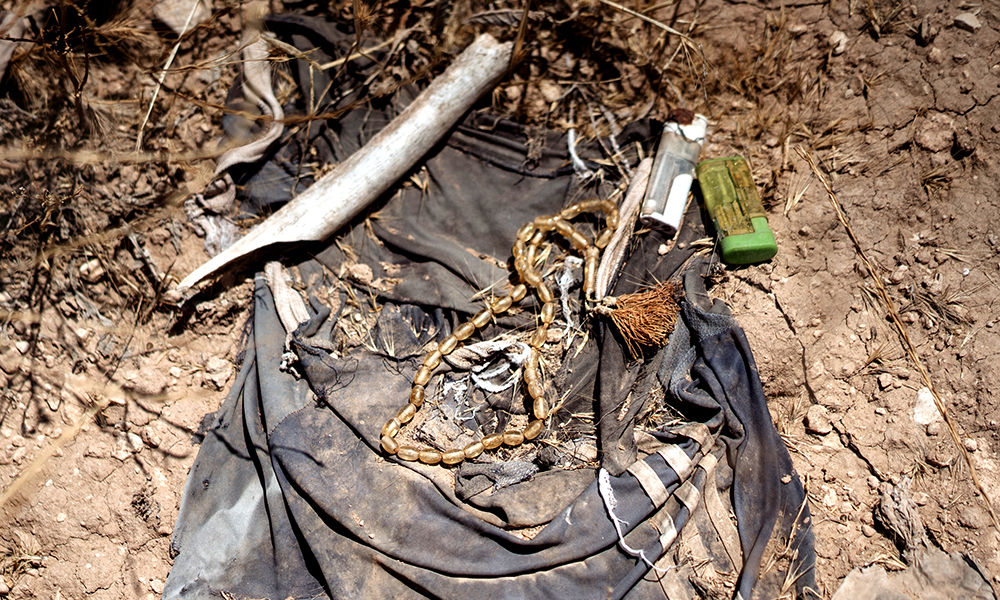
Clothing, prayer beads, cigarette lighters and fragments of bone at one of the mass Yazidi graves.
More remain in Syria. At the Baba Sheik’s orders and in defiance of a local stigma toward rape victims, hundreds of women who had been held as sex slaves were welcomed back to their communities. But any children they had with the ISIS men who raped them were rejected and would never be considered Yazidis. The customs that were meant to protect Yazidis forced mothers to choose between their homes and their children.
Farther up the valley is a small, square building with an empty red doorframe and concrete floor. Its bare walls and part of the ceiling have been carefully hung with framed portraits. Mustachioed men gaze solemnly at the camera, women smile, brothers sit arm-in-arm, teenagers pose awkward and proud in their graduation outfits. These are the missing, and there are so many that there is no more space on the walls and the older pictures lie in piles several deep, frames broken and glossy paper spilling out.
A few thousand Yazidis never left the Sinjar mountains in 2014, either lacking the money to live elsewhere or unwilling to trust anything but their own land. They watched while Peshmerga troops supported by the PKK and YPG guerrilla fighters established frontlines on the edge of Sinjar city and as U.S. jets hit ISIS positions inside it.
In November 2015, Kurdish groups, as well as newly formed Yazidi units, began an offensive to retake what was left of the city. Victory came quickly in the end, and ISIS did not fight hard. I moved with the Peshmerga as they advanced down the mountainside into scarred, empty streets, wary of the IEDs and snipers left behind. Whole sections had been pancaked by airstrikes, others burnt out, and black smoke rose from various points to the south. ISIS had dug tunnels underneath it all to hide from the jets and drones, then booby-trapped them as they left. Bottles of urine lay outside some of the entrances, tossed by fighters who did not want to risk stepping into the open.
Some of the Peshmerga celebrated, firing into the air and flashing victory signs from overloaded trucks, or in one case, from a captured ISIS suicide car bomb with barrels of explosives still in the back. This was a vindication after the previous August’s humiliating rout. Up on the roof of a school that ISIS had turned into a prison, a Yazidi fighter prayed toward the setting sun as others began kicking a soccer ball between themselves. Out in the long grass on the city’s fringes, the first of the mass graves were soon found. Some had not been dug deep, and bones were already showing through the topsoil along with any personal effects that had not rotted—prayer beads, a cigarette lighter, acrylic clothing.
Masoud Barzani, then president of the KRG, gave a press conference on the mountaintop that afternoon, microphones mounted on banks of sandbags as helicopters circled and occasionally drowned him out. “It’s time for the Yazidi girls to raise their heads up. Revenge has been taken for them,” he said, going on to promise that Sinjar would flourish once more as a Kurdish province.
Barzani’s words proved empty. His government was too busy fighting ISIS elsewhere and dealing with huge numbers of displaced Iraqis and Syrians. So Sinjar remained much as it was: without basic services and considered by most Yazidis to be far too dangerous to return to. The mass graves were marked with emergency tape but went unexcavated while vital forensic evidence of ISIS crimes was lost to the rain and sun.
Then in 2017, not long after ISIS was defeated as a territory-holding force in Iraq, Barzani pressed ahead with a controversial referendum seeking Kurdish independence. Enraged, Iraq’s federal government ordered its troops to take back the disputed territories. The Peshmerga withdrew once again, and Sinjar ended up controlled by a patchwork of Baghdad-payrolled groups, from local police to Yazidi PKK affiliates. For those living on the mountain, nothing much changed except the flags above the bases and checkpoints.
I have returned to Sinjar a number of times since the 2015 battle, and with each trip, I found a little more life in the city. Two of the main streets now have shops selling food basics and a few small restaurants with limited menus. Some local NGOs now operate there too. Only a small fraction of the previous population has returned, however, and much of the city is still rubble. The plains towns are emptier still, considered too vulnerable to attack by ISIS cells, and some of the villages controlled by PKK-linked militias are regularly hit by Turkish airstrikes. Even employees with NGOs dedicated to repopulating the Sinjar region privately admit it isn’t safe.
The main road through the mountain peaks is lined with corrugated-iron and chicken-wire shacks, tents and lean-tos, some covered with the same tarps that were airdropped in 2014. Materials to build sturdier shelters are out of reach for nearly everyone. Goats graze the yellow grass, and a few of the old terraces are back in use growing tobacco. There’s an international presence on the mountainside: a USAID project and an International Organization of Migration compound built around a prefabricated portable cabin. There’s a school, too, that teaches in Arabic rather than Kurdish, and a basic clinic, but not much else.
On an October afternoon last year, three men from Tel Ezêr, Tahseen’s village, beckoned me into a concrete-floored and sack-walled hut by the roadside. They were all cousins of one kind or another, with beards dyed black and sun-darkened skin. A small pile of Rothmans, MM and Continent cigarette packets were arranged in the middle of the floor, and the cousins sat crosslegged, working their way through them.
Serhan Khalif, 61, was the oldest. When he ran from ISIS, this part of the mountain was as far as he came, and he now served as a mukhtar or leader for 165 nearby families. Just existing there was difficult, and the men had seen very little of the international millions pledged in support of the Yazidis. They accused local aid organizations of taking expensive items from food baskets and exchanging aid for bribes. “The people on this road, they have no income,” Khalif said, waving downhill. “If they did, they could start a new life.”
They each thought it was still too dangerous to return to Tel Ezêr, and they distrusted the Arab neighbors who had turned on them. “This is us,” Khadir Hassan, 45, said, moving an ashtray into the center of the cigarette packets. “And these are our enemies. These are the Sunni Arab villages around us. One of their families will have an ISIS member, another whole household might be ISIS members…We used to eat and drink and do everything together with them, but they betrayed us.”
The solution, all three agreed, was an international force—UN peacekeepers perhaps, or the Americans—to secure the area around Sinjar so people felt safe to return. This was a request I had heard from Yazidis in Sinjar and elsewhere for years, and one that has virtually no chance of becoming a reality. But without this safeguard, none of the cousins could imagine a future there. Each had relatives like Tahseen who had traveled abroad, and one or two more families continued to leave their part of the mountain every week hoping to do the same.
“If we get the chance, everyone will go,” Khalif said. This, too, I had heard again and again. I asked what that would mean for Yazidis. “It’s bad,” he replied. “But it’s better than death.”
Some of those diaspora Yazidis were among the Cemaiya crowd, conspicuous like Tahseen for their European clothes and relative pallor. I meet Salam Rasho, 40, as he completes his walk through the temple in a crisp shirt and expensive-looking blazer, and we climb together to the spot where his family has made their camp. He joins his 63-year-old uncle, who goes by the name of Abu Zina and sits crosslegged on a row of cushions in loose Kurdish trousers. Rasho has just arrived from Oslo, where he has lived with his wife and children since 2002, adapting to traffic laws and snow while advancing his way from factory line worker to hotel owner. He has become in many ways Scandinavian since then, picking up cycling and a conversational obsession with the weather. Along the way, he also lost his faith. “Our family has become much more open,” he laughs, switching to Norwegian. “Before, I used to believe in God; now I just believe in myself.”
While he strayed, his uncle Abu Zina has continued to study Yazidi traditions, learning their history and committing the genocides by Ottoman leaders to memory. When ISIS came in 2014, he picked up a gun, but he was not able to save a sister who was taken and another who died of exposure. He still lives in a tent on the mountain and has no intention of abandoning what he says is his people’s capital. Leaving Iraq might be safer, he concedes, but he worries that the Yazidi faith would melt away across continents and countries. “We will have to follow all of their rules, the children will go to school and forget our land, forget our language and all of the holy things.”
Abu Zina had not been able to convince even his own family of this. His 27-year-old daughter is now studying in Hanover, Germany, after graduating from an Iraqi medical school and wants to settle there. “I sent her to Germany for the experience and education, and she never came back,” he says. Rasho switches to Norwegian again. “How can his daughter come back to this?” he asks. “There is a big divide between those who left and those who stayed and are so closed off.”
Tahseen is still somewhere in between. He is enjoying his time back in Iraq and plans to spend another two weeks here. Mostly eating and sleeping, he tells me, grinning so his gold tooth shows, as well as spending as much time with his remaining family as possible. But like everyone else, so many of his loved ones are still missing.
His sister Afrah, though, survived. ISIS moved her and her children from prison to makeshift prison for months, tormenting and threatening to slaughter them all the while. Once, as fighters drove them through Sinjar, an airstrike landed close to the car, and in the confusion they were able to escape on foot up onto the mountain slopes. As a survivor, she was soon given asylum in Germany.
She chose not to come back for the Feast of the Assembly, perhaps having no wish to be reminded of a land where she suffered so much or the religious identity for which she had been persecuted.
Without their traditions, Abu Zina tells me, Yazidis have only memories. After ISIS, some Yazidis no longer want those either.
John Beck is an award-winning journalist focused on conflict and its aftermath. His work has been published by outlets including GQ, National Geographic, Wired and The Atlantic.



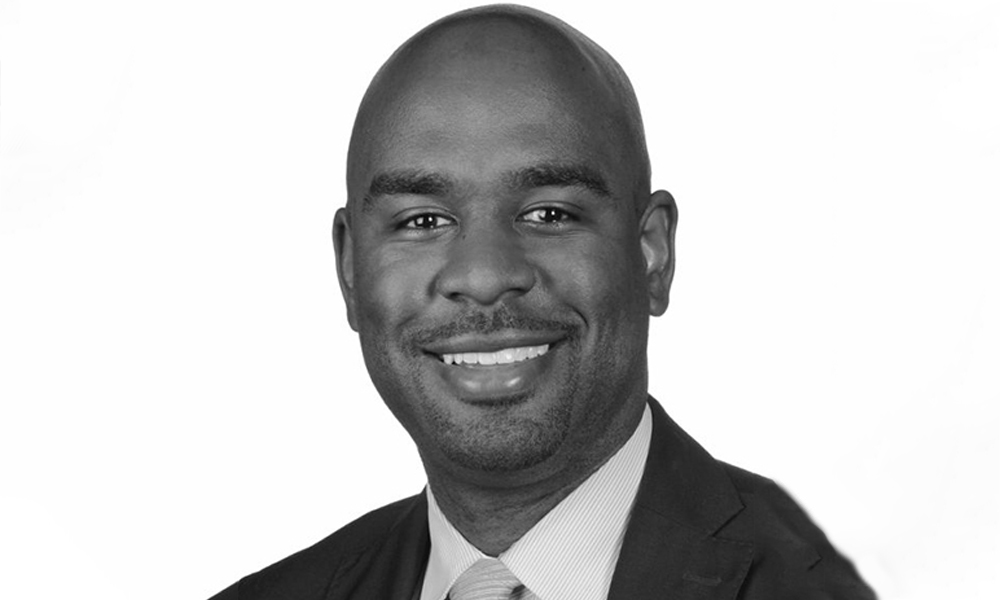


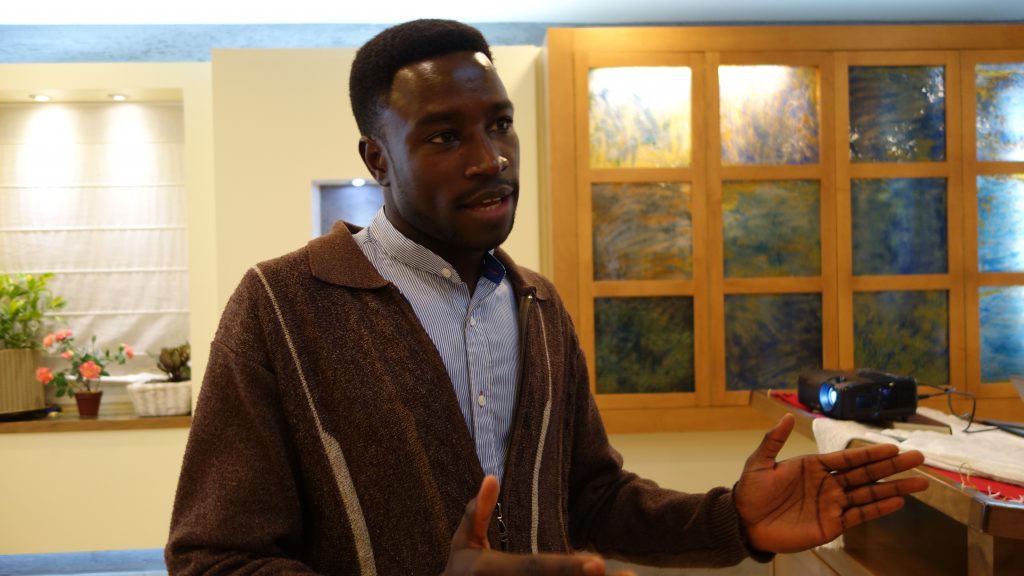


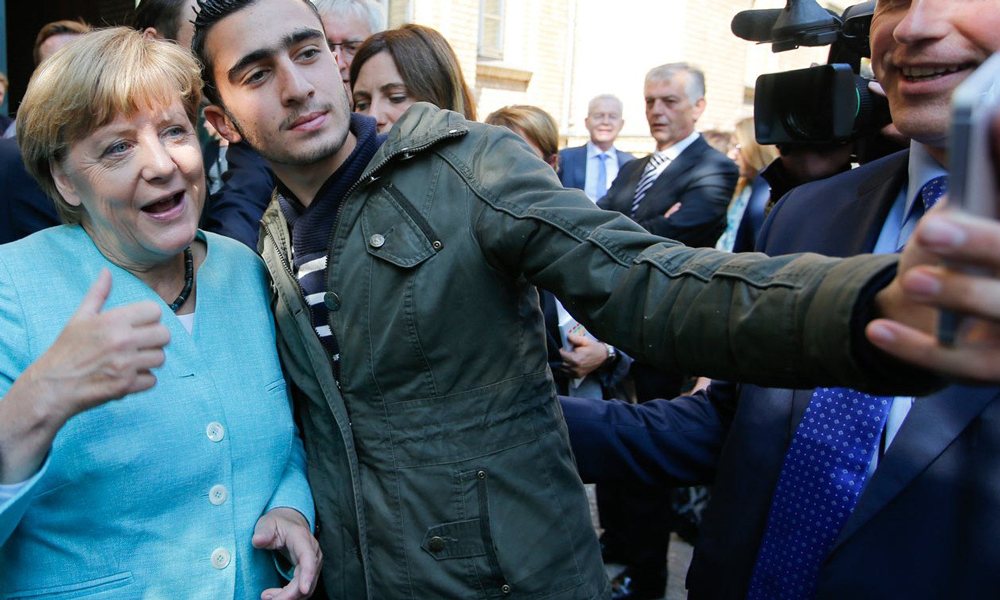




I think this has left the country youth devastated. What is left to come back?
our years after the IS invasion, Yazidis in northern Iraq feel they have live on these slopes, even though the extremist group no longer controls this area. their faith and culture, recognized by the United Nations as genocide
Good read, for your information, Sheikh adi isn’t the founder of this religion, he only helped to collect the Yazidis left from the genocides so this religion doesn’t die or go extinct.